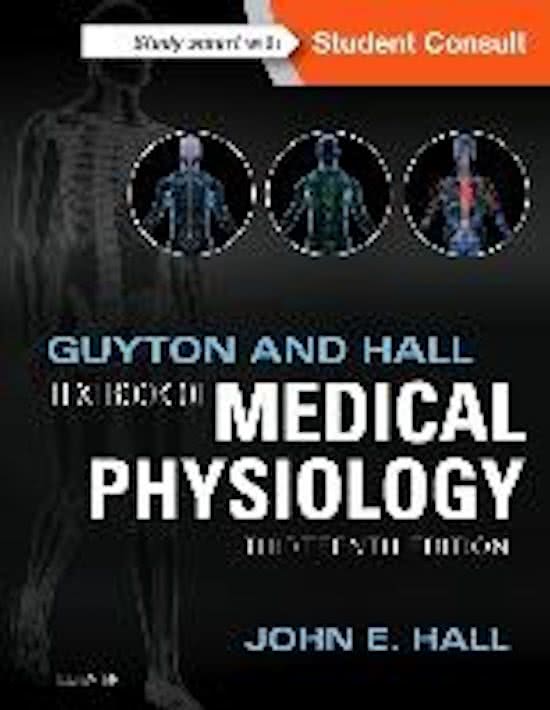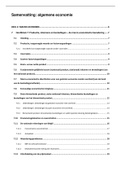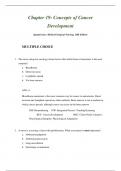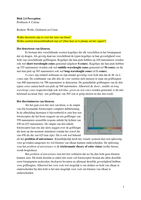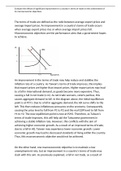Sensory Information
Medical Physiology1: Chapters 46, 47, 48, 49 (p. 577-632)
Basics of the nervous system
Medical Physiology: Chapter 46 (p. 577-592)
The nervous system in general
The sensory part of the nervous system receives information from the whole body (surface
and some deep structures) and processes in different sensory areas. Important sensory
information that reaches the brain is channelled to the right part of the brain where it is
processed: the integrative function of the nervous system. The motor part controls muscles
and glands.
The memory part of the brain makes sure we can retain information for future use. Every
time a certain type of signal pass through the same sequence of synapses, these synapses
become more capable of transmitting this type of signal the next time: facilitation. Eventually,
the synapses can become so facilitated that the circuit does not need sensory input anymore
to be activated: it can also be activated by other signals in the brain.
Levels of nervous system function
The nervous system has three levels of function: the spinal cord, the lower brain (subcortical
level), and the higher brain (cortical level). The spinal cord deals with reflexes. The lower
brain deals with subconscious activities. The higher brain deals with the memory, thoughts
and the precision of the actions of the lower levels of the nervous system.
Synapses in the central nervous system
Anatomy
The soma is the main body of the neuron. It gets signals from presynaptic terminals on its
dendrites and its soma. Those signals pass through the body to the axon.
Electrical synapses
Electrical synapses are the synapses of cells that are directly connect with gap junctions.
This type of synapses is seen in smooth muscle fibers. Electrical synapses can transmit
signals in both directions, which is not possible with chemical synapses.
Chemical synapses
Chemical synapses work with neurotransmitters that act on receptors on the membrane of
the next cell. The receptors decide if the signal is interpreted as excitatory or inhibitory. Most
synapses in the brain are chemical.
The neurotransmitter is released in the following way:
1. The presynaptic membrane is depolarised by an action potential.
2. The depolarisation opens the voltage-gated calcium channels.
3. The inflowing calcium binds to release sites which open.
4. The vesicles with neurotransmitter are released and the neurotransmitter enters the
synaptic cleft.
5. The neurotransmitter can either directly open the ion channel on the postsynaptic
membrane (ionotropic receptor) or activate a second messenger (metabotropic
receptor).
Chemical receptors
1
Textbook of Medical Physiology - Guyton & Hall, 13th edition
, By Nerea Campillo
Ionotropic receptors
Ionotropic receptors are ion channels that either let through cations (positive ions, mostly
sodium) or anions (negative ions, mostly calcium) when they are activated by a
neurotransmitter. Cation channels are negatively charged to attract the positive ions and
repel the negative ions. Anions channels block positive ions because those are too big to fit
through the small anion channels.
Metabotropic receptors
Metabotropic receptors activate a second messenger upon activation by a neurotransmitter.
This has the benefit of being able to give a prolonged signal (unlike with ionotropic
receptors).
The G proteins are the most common type of second messenger proteins. G proteins have
GDP attached to them when they are inactive. When the receptor on the membrane gets
activated by the neurotransmitter, a binding site for the G protein complex becomes
available. The GDP is released then and a GTP is attached. The energy from this GTP can:
open specific ion channels, activated cAMP or cGMP, activate intracellular enzymes or
activate gene transcription.
Excitation and inhibition by receptors
Receptors have different ways of causing excitation or inhibition in the cell.
Excitation:
● Opening of sodium channels → raises the membrane potential towards the
threshold
● Suppression of chloride or potassium channels → raises the membrane
potential
● Changes in the internal membrane
Inhibition:
● Opening of chloride channels → lowers the membrane potential
● Increasing the flow of potassium out of the neuron → lowers the
membrane potential
● Activation of enzymes that inhibit metabolic functions
Neurotransmitters and neuropeptides
Neurotransmitters
Neurotransmitters are small molecules that act fast. They are made in the cytosol of the
ends of the presynaptic cell where they are stored in transmitter vesicles. These vesicles are
recycled. Neurotransmitters usually cause the increase or decrease of conductance through
ion channels.
Examples:
● Acetylcholine
Used in: pyramidal cells in motor cortex, basal ganglia, motor neurons of skeletal
muscles, preganglionic neurons of ANS, postganglionic neurons of parasympathetic
nervous system.
Effect: excitation.
Exception: inhibition of the heart by the vagus nerve.
● Norepinephrine
Used in: brainstem, hypothalamus, postganglionic neurons of the sympathetic
nervous system.
Effect: mainly excitation


